Organization Development Strategies and Analysis: Coca-Cola Report
VerifiedAdded on 2020/04/01
|15
|2423
|65
Report
AI Summary
This report provides an in-depth analysis of Coca-Cola's organizational development strategies. It examines the company's approach to maintaining a competitive edge in the beverage industry, focusing on key initiatives such as foreign direct investment, product diversification, and the adoption of new technologies. The report delves into Coca-Cola's responses to challenges like market competition and government policies, highlighting the importance of research-driven decision-making and stakeholder involvement. It also discusses the company's ability to adapt to global market dynamics, emphasizing lessons learned regarding risk management, strategic planning, and the significance of employee welfare. The report concludes with recommendations for continued success, underscoring the need for innovation, market research, and proactive management in a dynamic business environment.
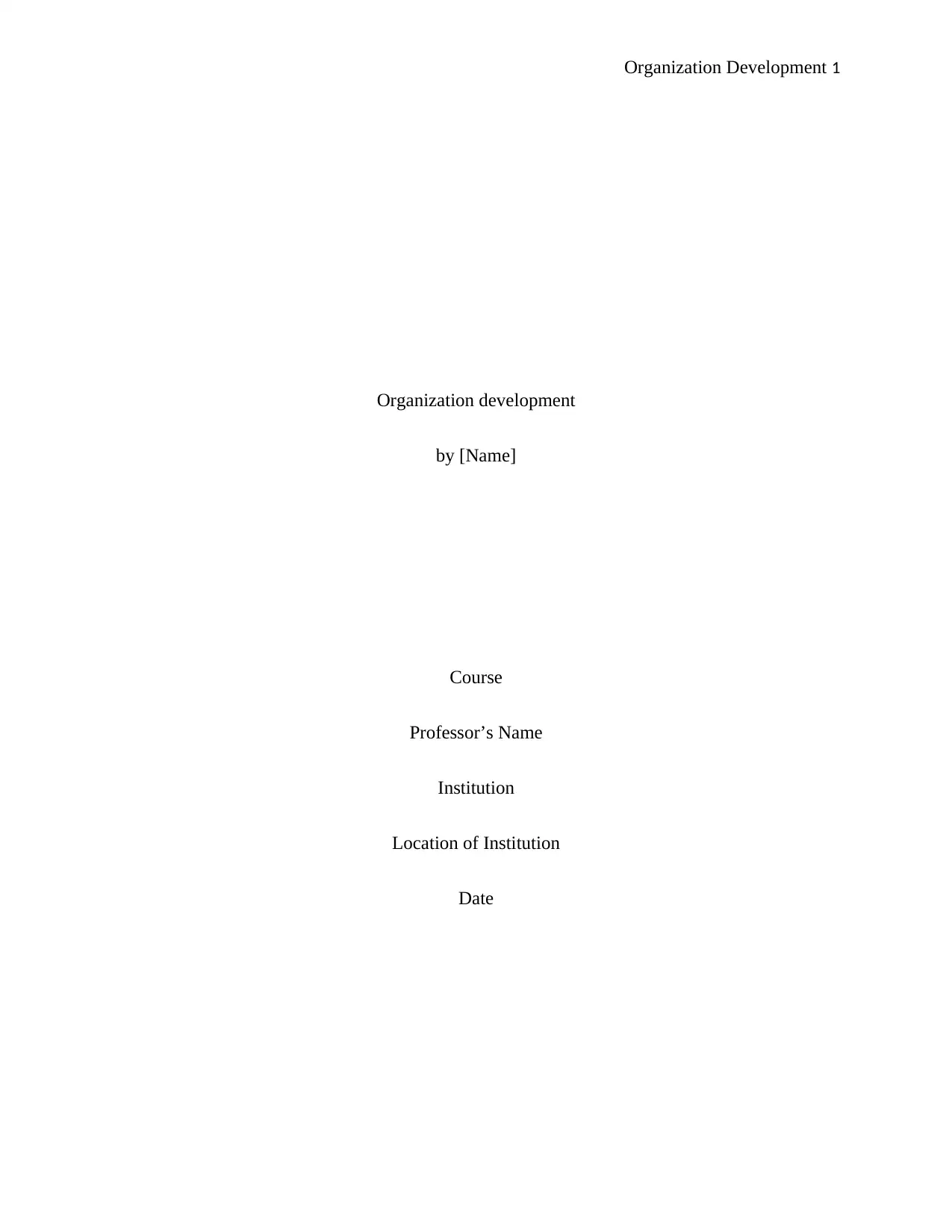
Organization Development 1
Organization development
by [Name]
Course
Professor’s Name
Institution
Location of Institution
Date
Organization development
by [Name]
Course
Professor’s Name
Institution
Location of Institution
Date
Paraphrase This Document
Need a fresh take? Get an instant paraphrase of this document with our AI Paraphraser
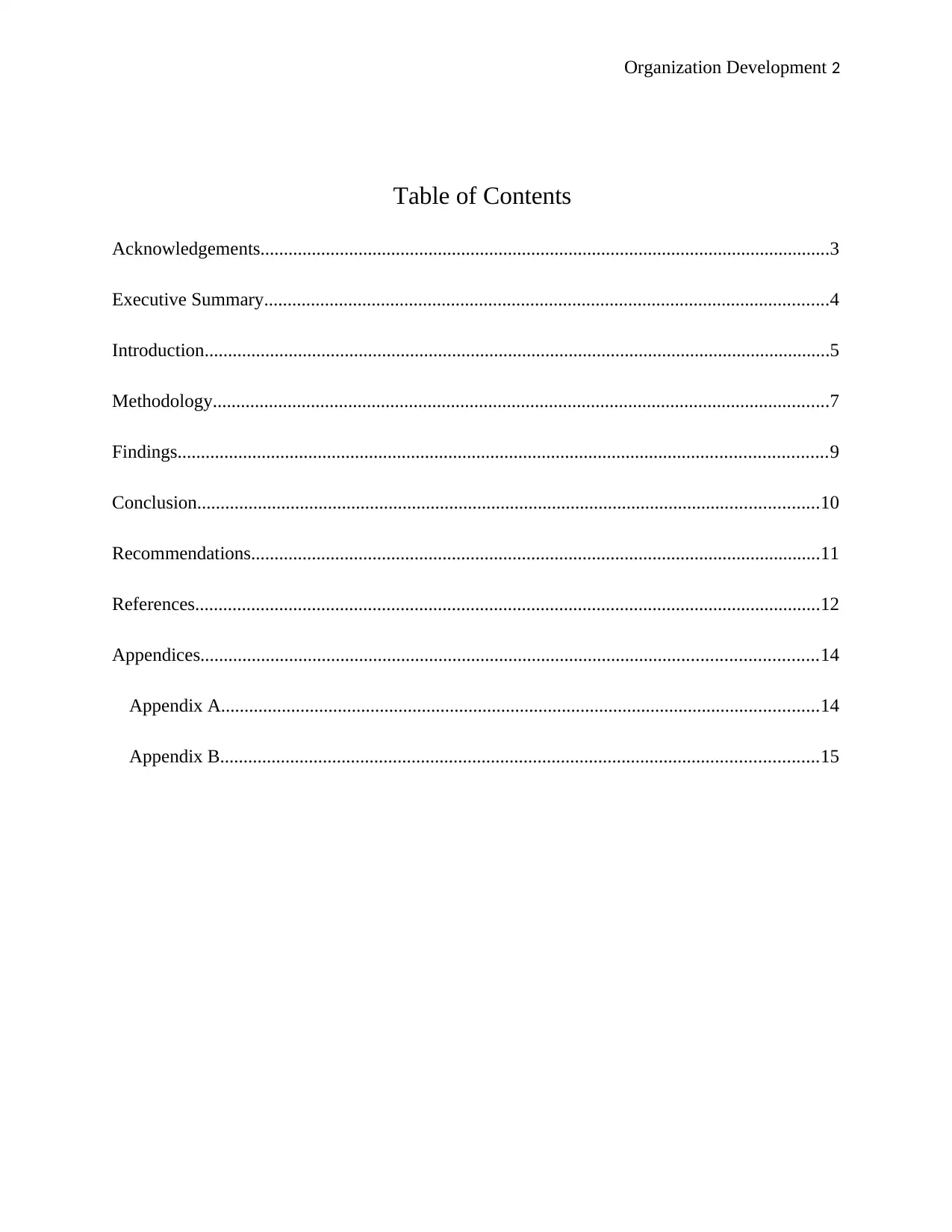
Organization Development 2
Table of Contents
Acknowledgements..........................................................................................................................3
Executive Summary.........................................................................................................................4
Introduction......................................................................................................................................5
Methodology....................................................................................................................................7
Findings...........................................................................................................................................9
Conclusion.....................................................................................................................................10
Recommendations..........................................................................................................................11
References......................................................................................................................................12
Appendices....................................................................................................................................14
Appendix A................................................................................................................................14
Appendix B................................................................................................................................15
Table of Contents
Acknowledgements..........................................................................................................................3
Executive Summary.........................................................................................................................4
Introduction......................................................................................................................................5
Methodology....................................................................................................................................7
Findings...........................................................................................................................................9
Conclusion.....................................................................................................................................10
Recommendations..........................................................................................................................11
References......................................................................................................................................12
Appendices....................................................................................................................................14
Appendix A................................................................................................................................14
Appendix B................................................................................................................................15
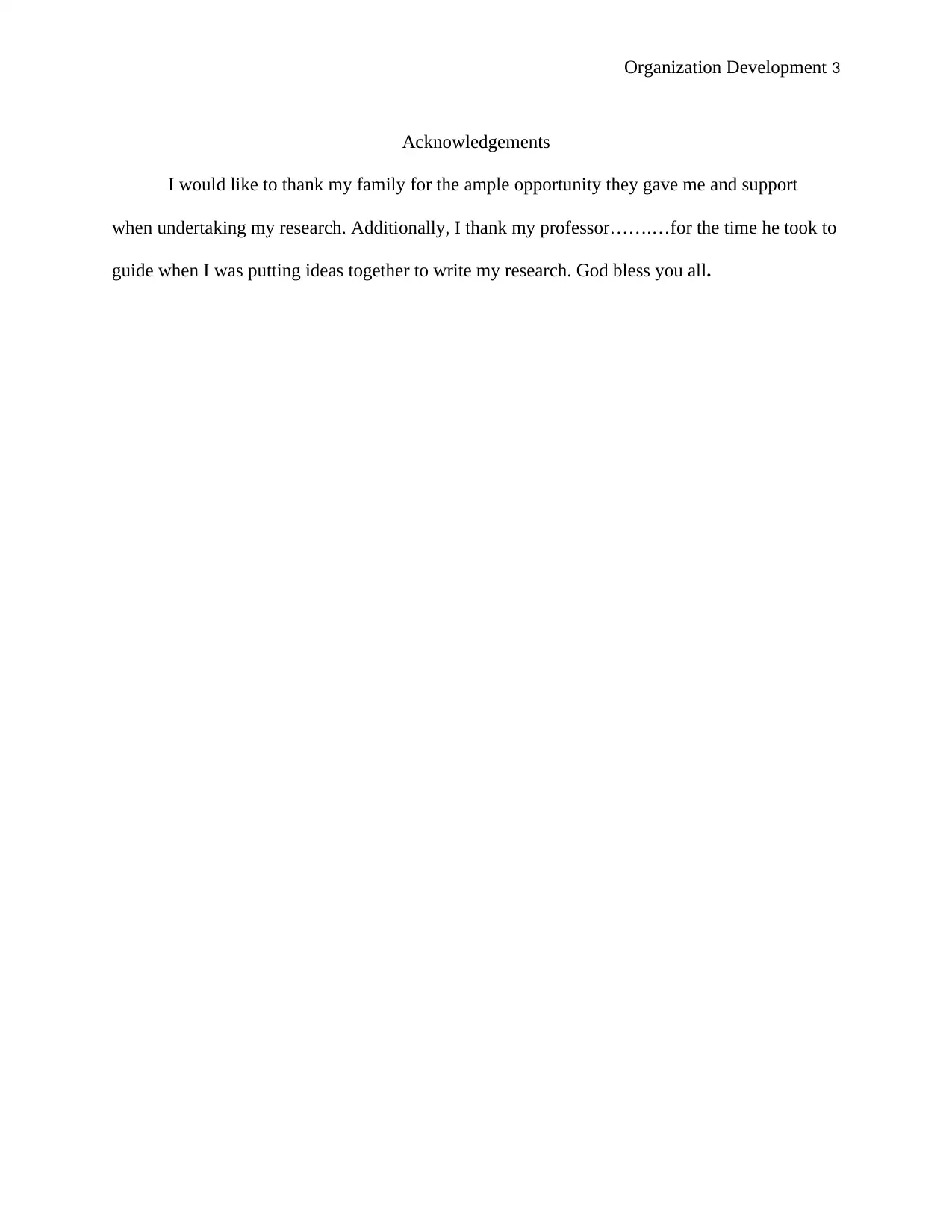
Organization Development 3
Acknowledgements
I would like to thank my family for the ample opportunity they gave me and support
when undertaking my research. Additionally, I thank my professor…….…for the time he took to
guide when I was putting ideas together to write my research. God bless you all.
Acknowledgements
I would like to thank my family for the ample opportunity they gave me and support
when undertaking my research. Additionally, I thank my professor…….…for the time he took to
guide when I was putting ideas together to write my research. God bless you all.
⊘ This is a preview!⊘
Do you want full access?
Subscribe today to unlock all pages.

Trusted by 1+ million students worldwide
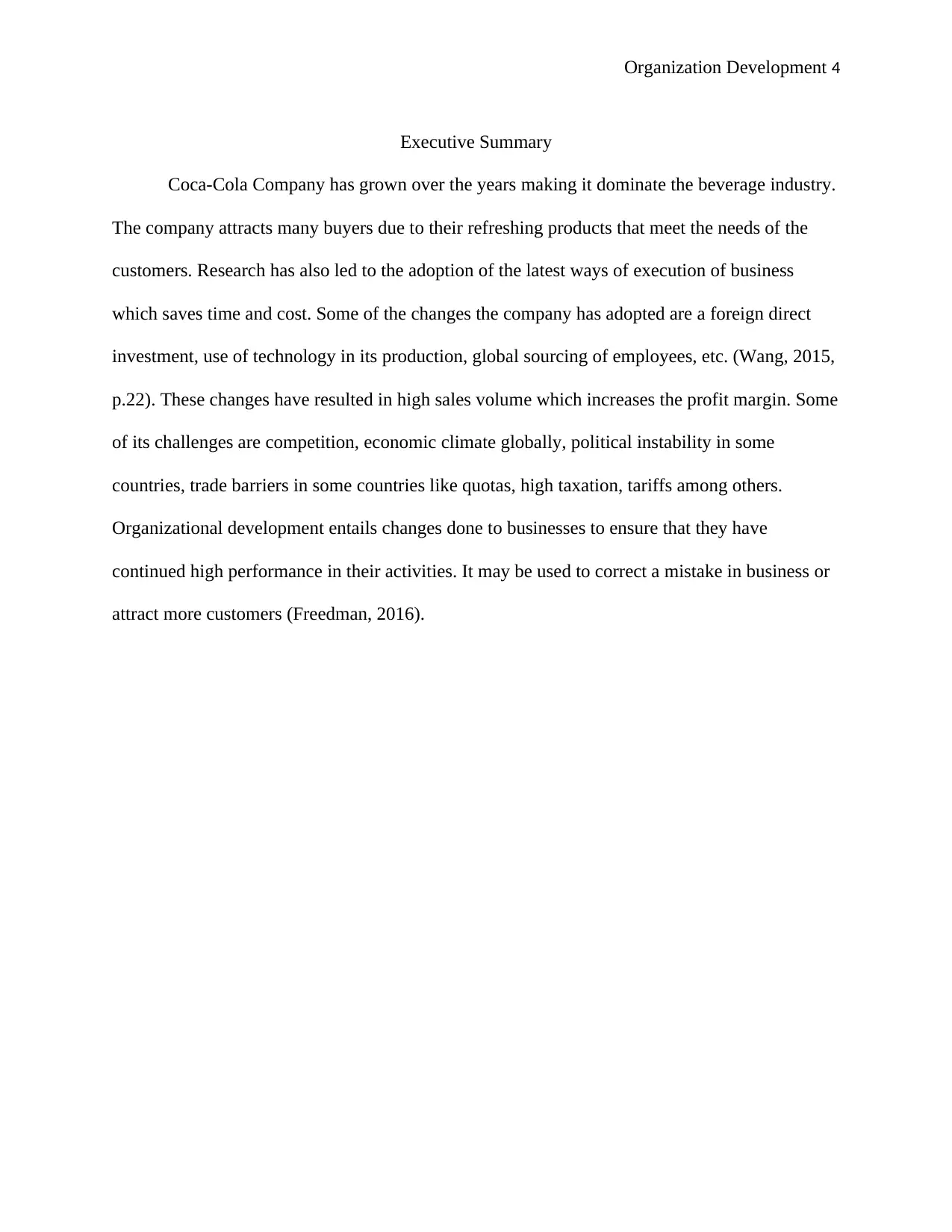
Organization Development 4
Executive Summary
Coca-Cola Company has grown over the years making it dominate the beverage industry.
The company attracts many buyers due to their refreshing products that meet the needs of the
customers. Research has also led to the adoption of the latest ways of execution of business
which saves time and cost. Some of the changes the company has adopted are a foreign direct
investment, use of technology in its production, global sourcing of employees, etc. (Wang, 2015,
p.22). These changes have resulted in high sales volume which increases the profit margin. Some
of its challenges are competition, economic climate globally, political instability in some
countries, trade barriers in some countries like quotas, high taxation, tariffs among others.
Organizational development entails changes done to businesses to ensure that they have
continued high performance in their activities. It may be used to correct a mistake in business or
attract more customers (Freedman, 2016).
Executive Summary
Coca-Cola Company has grown over the years making it dominate the beverage industry.
The company attracts many buyers due to their refreshing products that meet the needs of the
customers. Research has also led to the adoption of the latest ways of execution of business
which saves time and cost. Some of the changes the company has adopted are a foreign direct
investment, use of technology in its production, global sourcing of employees, etc. (Wang, 2015,
p.22). These changes have resulted in high sales volume which increases the profit margin. Some
of its challenges are competition, economic climate globally, political instability in some
countries, trade barriers in some countries like quotas, high taxation, tariffs among others.
Organizational development entails changes done to businesses to ensure that they have
continued high performance in their activities. It may be used to correct a mistake in business or
attract more customers (Freedman, 2016).
Paraphrase This Document
Need a fresh take? Get an instant paraphrase of this document with our AI Paraphraser
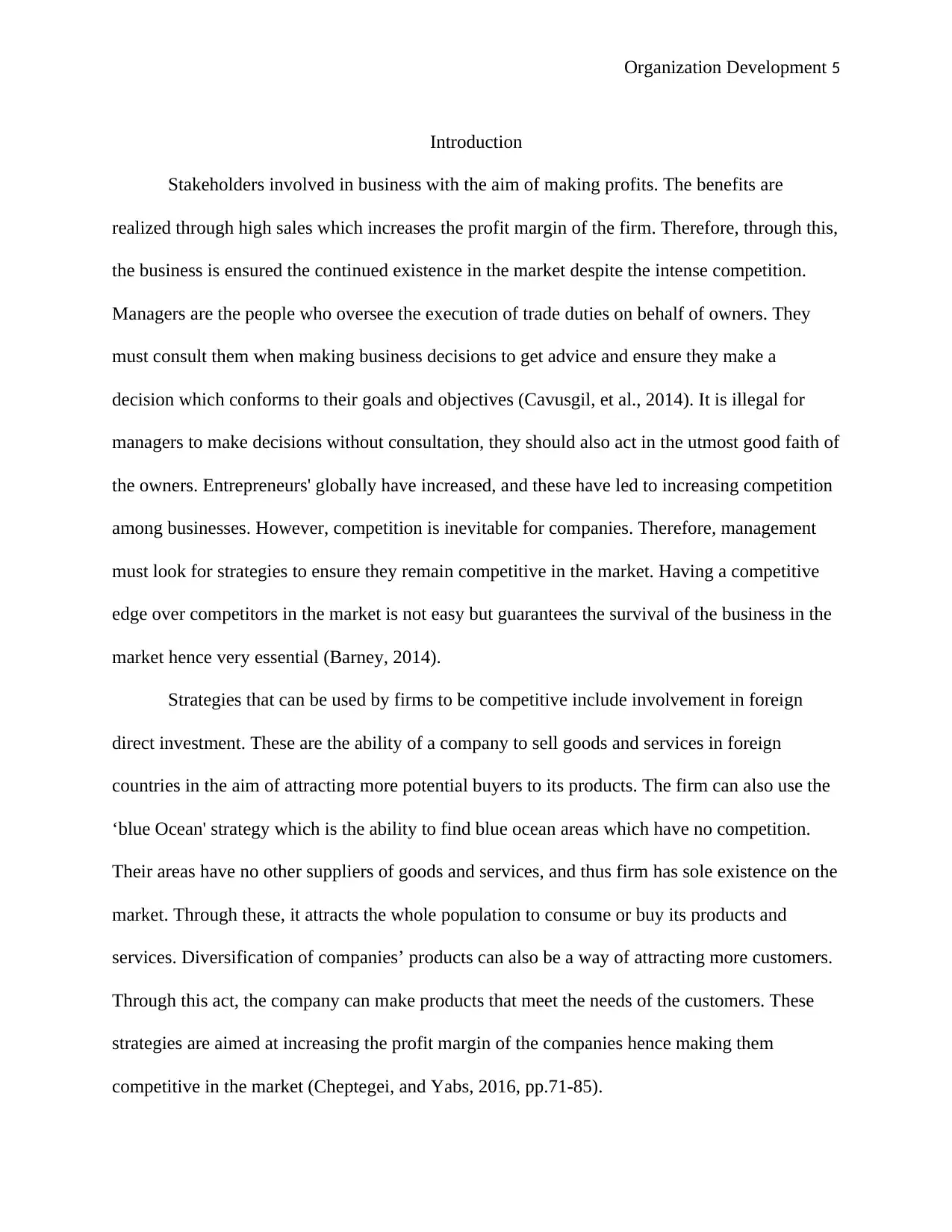
Organization Development 5
Introduction
Stakeholders involved in business with the aim of making profits. The benefits are
realized through high sales which increases the profit margin of the firm. Therefore, through this,
the business is ensured the continued existence in the market despite the intense competition.
Managers are the people who oversee the execution of trade duties on behalf of owners. They
must consult them when making business decisions to get advice and ensure they make a
decision which conforms to their goals and objectives (Cavusgil, et al., 2014). It is illegal for
managers to make decisions without consultation, they should also act in the utmost good faith of
the owners. Entrepreneurs' globally have increased, and these have led to increasing competition
among businesses. However, competition is inevitable for companies. Therefore, management
must look for strategies to ensure they remain competitive in the market. Having a competitive
edge over competitors in the market is not easy but guarantees the survival of the business in the
market hence very essential (Barney, 2014).
Strategies that can be used by firms to be competitive include involvement in foreign
direct investment. These are the ability of a company to sell goods and services in foreign
countries in the aim of attracting more potential buyers to its products. The firm can also use the
‘blue Ocean' strategy which is the ability to find blue ocean areas which have no competition.
Their areas have no other suppliers of goods and services, and thus firm has sole existence on the
market. Through these, it attracts the whole population to consume or buy its products and
services. Diversification of companies’ products can also be a way of attracting more customers.
Through this act, the company can make products that meet the needs of the customers. These
strategies are aimed at increasing the profit margin of the companies hence making them
competitive in the market (Cheptegei, and Yabs, 2016, pp.71-85).
Introduction
Stakeholders involved in business with the aim of making profits. The benefits are
realized through high sales which increases the profit margin of the firm. Therefore, through this,
the business is ensured the continued existence in the market despite the intense competition.
Managers are the people who oversee the execution of trade duties on behalf of owners. They
must consult them when making business decisions to get advice and ensure they make a
decision which conforms to their goals and objectives (Cavusgil, et al., 2014). It is illegal for
managers to make decisions without consultation, they should also act in the utmost good faith of
the owners. Entrepreneurs' globally have increased, and these have led to increasing competition
among businesses. However, competition is inevitable for companies. Therefore, management
must look for strategies to ensure they remain competitive in the market. Having a competitive
edge over competitors in the market is not easy but guarantees the survival of the business in the
market hence very essential (Barney, 2014).
Strategies that can be used by firms to be competitive include involvement in foreign
direct investment. These are the ability of a company to sell goods and services in foreign
countries in the aim of attracting more potential buyers to its products. The firm can also use the
‘blue Ocean' strategy which is the ability to find blue ocean areas which have no competition.
Their areas have no other suppliers of goods and services, and thus firm has sole existence on the
market. Through these, it attracts the whole population to consume or buy its products and
services. Diversification of companies’ products can also be a way of attracting more customers.
Through this act, the company can make products that meet the needs of the customers. These
strategies are aimed at increasing the profit margin of the companies hence making them
competitive in the market (Cheptegei, and Yabs, 2016, pp.71-85).
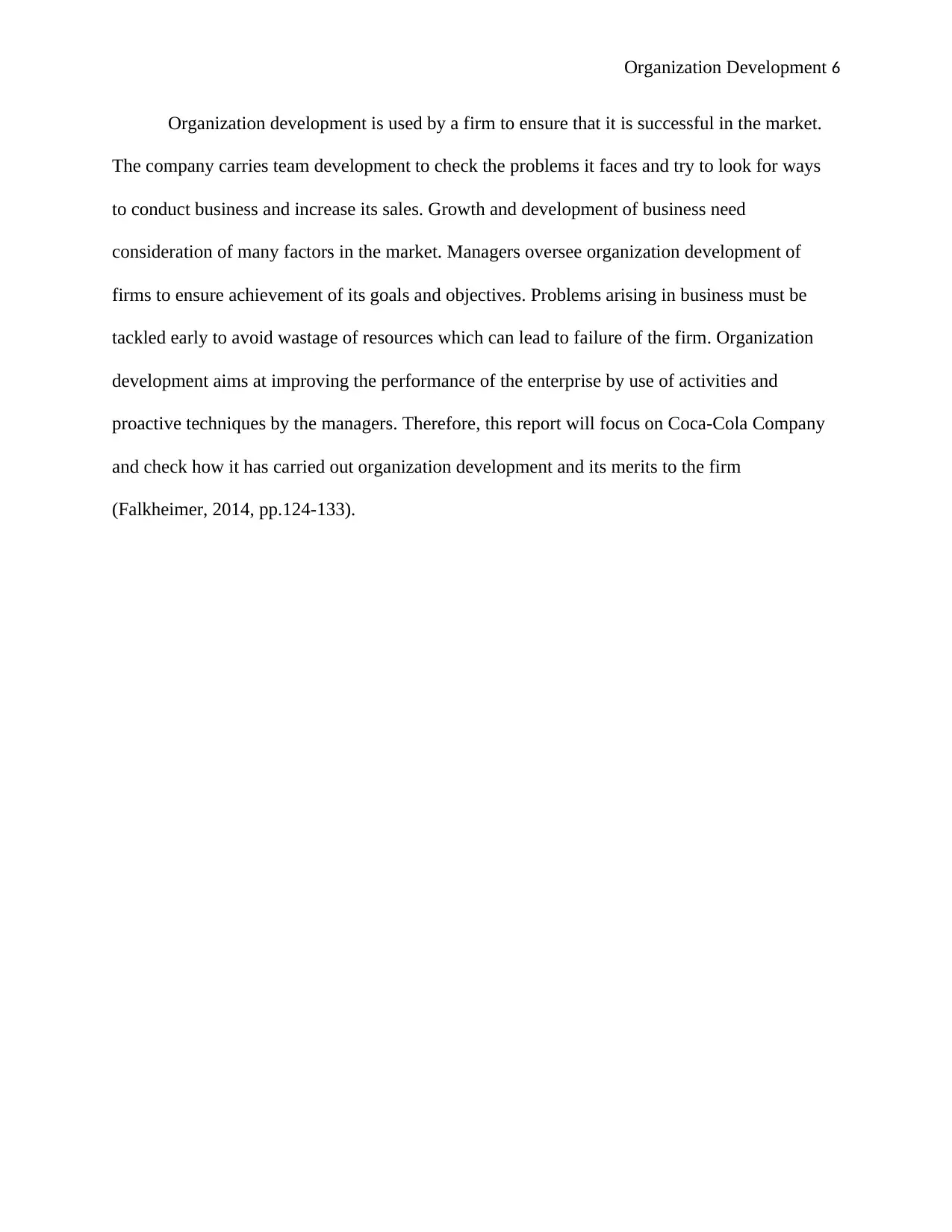
Organization Development 6
Organization development is used by a firm to ensure that it is successful in the market.
The company carries team development to check the problems it faces and try to look for ways
to conduct business and increase its sales. Growth and development of business need
consideration of many factors in the market. Managers oversee organization development of
firms to ensure achievement of its goals and objectives. Problems arising in business must be
tackled early to avoid wastage of resources which can lead to failure of the firm. Organization
development aims at improving the performance of the enterprise by use of activities and
proactive techniques by the managers. Therefore, this report will focus on Coca-Cola Company
and check how it has carried out organization development and its merits to the firm
(Falkheimer, 2014, pp.124-133).
Organization development is used by a firm to ensure that it is successful in the market.
The company carries team development to check the problems it faces and try to look for ways
to conduct business and increase its sales. Growth and development of business need
consideration of many factors in the market. Managers oversee organization development of
firms to ensure achievement of its goals and objectives. Problems arising in business must be
tackled early to avoid wastage of resources which can lead to failure of the firm. Organization
development aims at improving the performance of the enterprise by use of activities and
proactive techniques by the managers. Therefore, this report will focus on Coca-Cola Company
and check how it has carried out organization development and its merits to the firm
(Falkheimer, 2014, pp.124-133).
⊘ This is a preview!⊘
Do you want full access?
Subscribe today to unlock all pages.

Trusted by 1+ million students worldwide
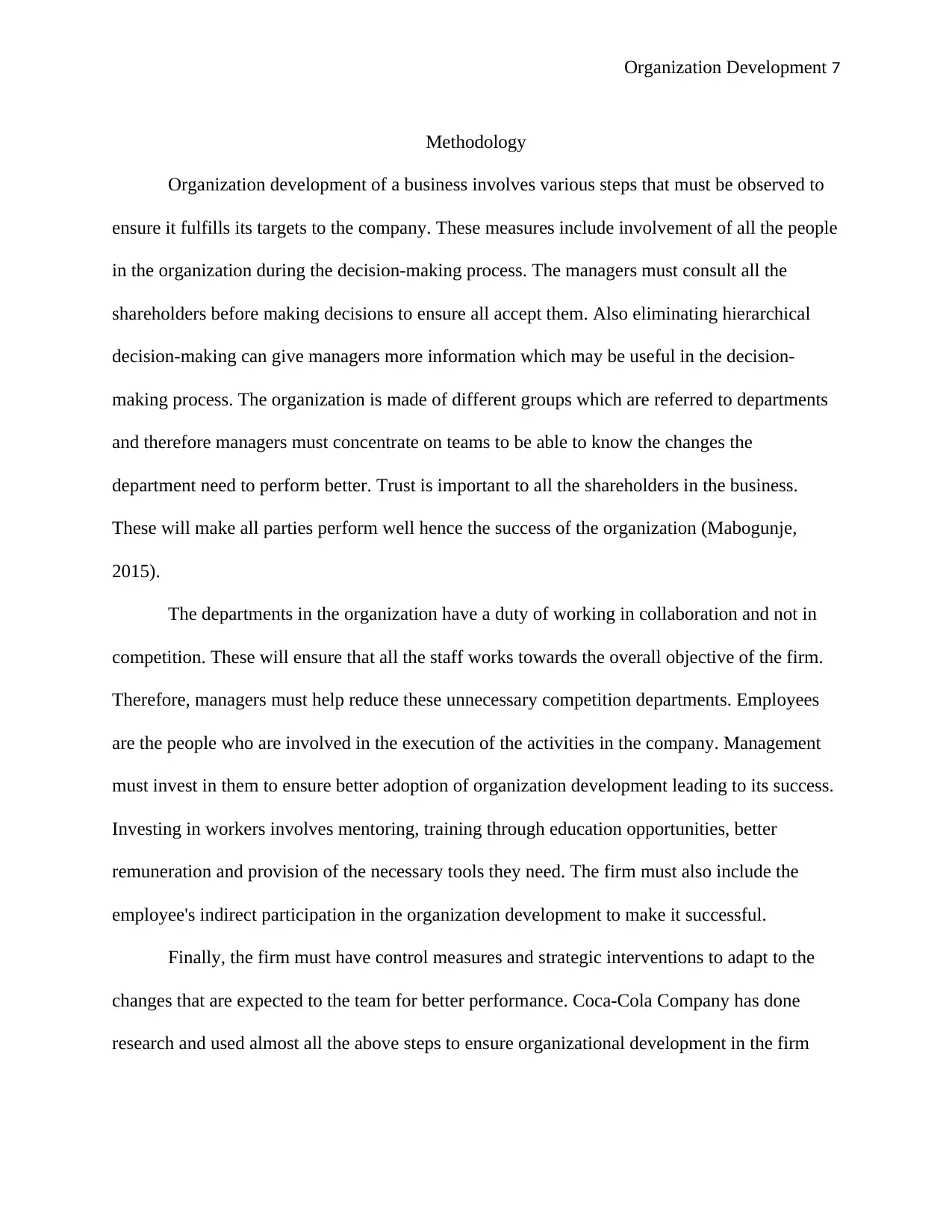
Organization Development 7
Methodology
Organization development of a business involves various steps that must be observed to
ensure it fulfills its targets to the company. These measures include involvement of all the people
in the organization during the decision-making process. The managers must consult all the
shareholders before making decisions to ensure all accept them. Also eliminating hierarchical
decision-making can give managers more information which may be useful in the decision-
making process. The organization is made of different groups which are referred to departments
and therefore managers must concentrate on teams to be able to know the changes the
department need to perform better. Trust is important to all the shareholders in the business.
These will make all parties perform well hence the success of the organization (Mabogunje,
2015).
The departments in the organization have a duty of working in collaboration and not in
competition. These will ensure that all the staff works towards the overall objective of the firm.
Therefore, managers must help reduce these unnecessary competition departments. Employees
are the people who are involved in the execution of the activities in the company. Management
must invest in them to ensure better adoption of organization development leading to its success.
Investing in workers involves mentoring, training through education opportunities, better
remuneration and provision of the necessary tools they need. The firm must also include the
employee's indirect participation in the organization development to make it successful.
Finally, the firm must have control measures and strategic interventions to adapt to the
changes that are expected to the team for better performance. Coca-Cola Company has done
research and used almost all the above steps to ensure organizational development in the firm
Methodology
Organization development of a business involves various steps that must be observed to
ensure it fulfills its targets to the company. These measures include involvement of all the people
in the organization during the decision-making process. The managers must consult all the
shareholders before making decisions to ensure all accept them. Also eliminating hierarchical
decision-making can give managers more information which may be useful in the decision-
making process. The organization is made of different groups which are referred to departments
and therefore managers must concentrate on teams to be able to know the changes the
department need to perform better. Trust is important to all the shareholders in the business.
These will make all parties perform well hence the success of the organization (Mabogunje,
2015).
The departments in the organization have a duty of working in collaboration and not in
competition. These will ensure that all the staff works towards the overall objective of the firm.
Therefore, managers must help reduce these unnecessary competition departments. Employees
are the people who are involved in the execution of the activities in the company. Management
must invest in them to ensure better adoption of organization development leading to its success.
Investing in workers involves mentoring, training through education opportunities, better
remuneration and provision of the necessary tools they need. The firm must also include the
employee's indirect participation in the organization development to make it successful.
Finally, the firm must have control measures and strategic interventions to adapt to the
changes that are expected to the team for better performance. Coca-Cola Company has done
research and used almost all the above steps to ensure organizational development in the firm
Paraphrase This Document
Need a fresh take? Get an instant paraphrase of this document with our AI Paraphraser
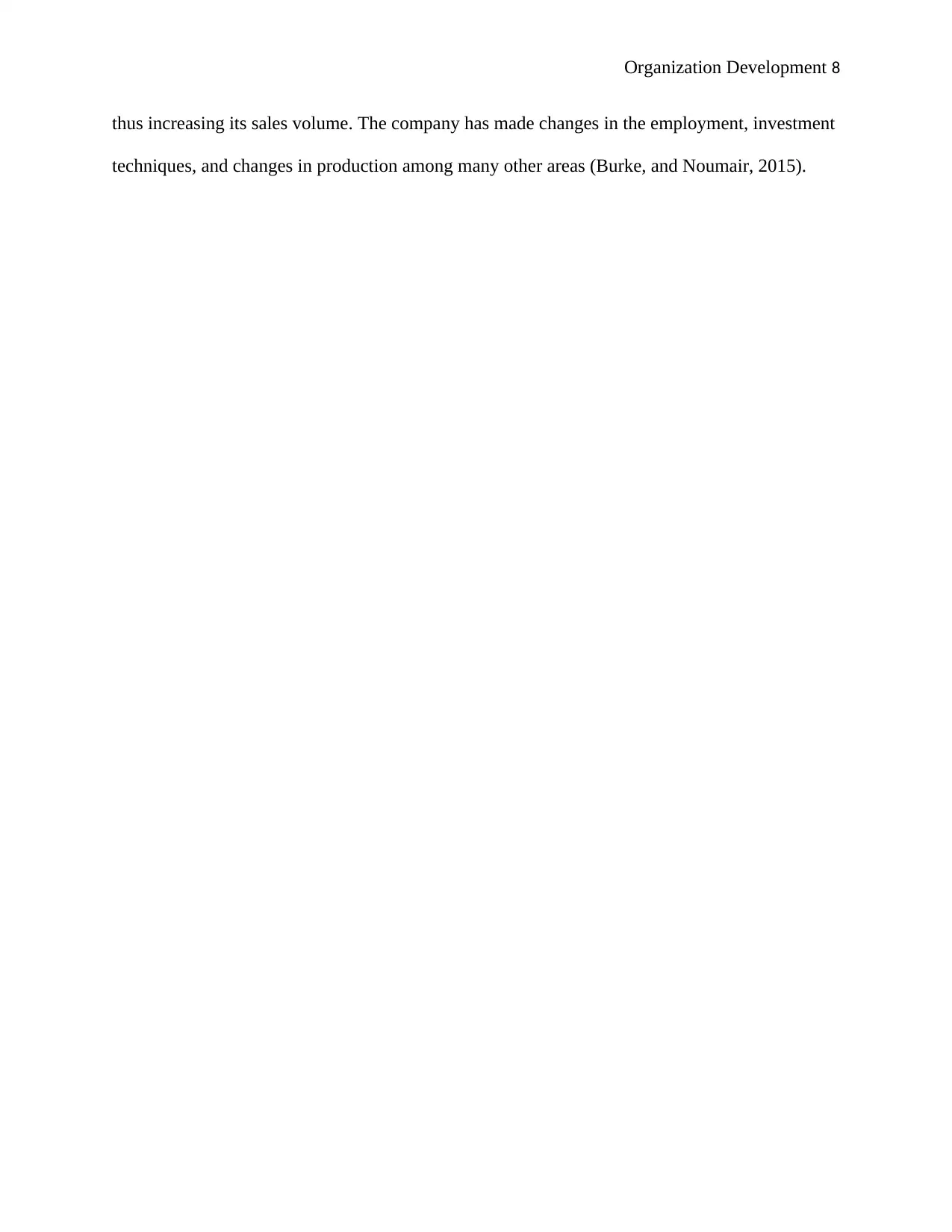
Organization Development 8
thus increasing its sales volume. The company has made changes in the employment, investment
techniques, and changes in production among many other areas (Burke, and Noumair, 2015).
thus increasing its sales volume. The company has made changes in the employment, investment
techniques, and changes in production among many other areas (Burke, and Noumair, 2015).
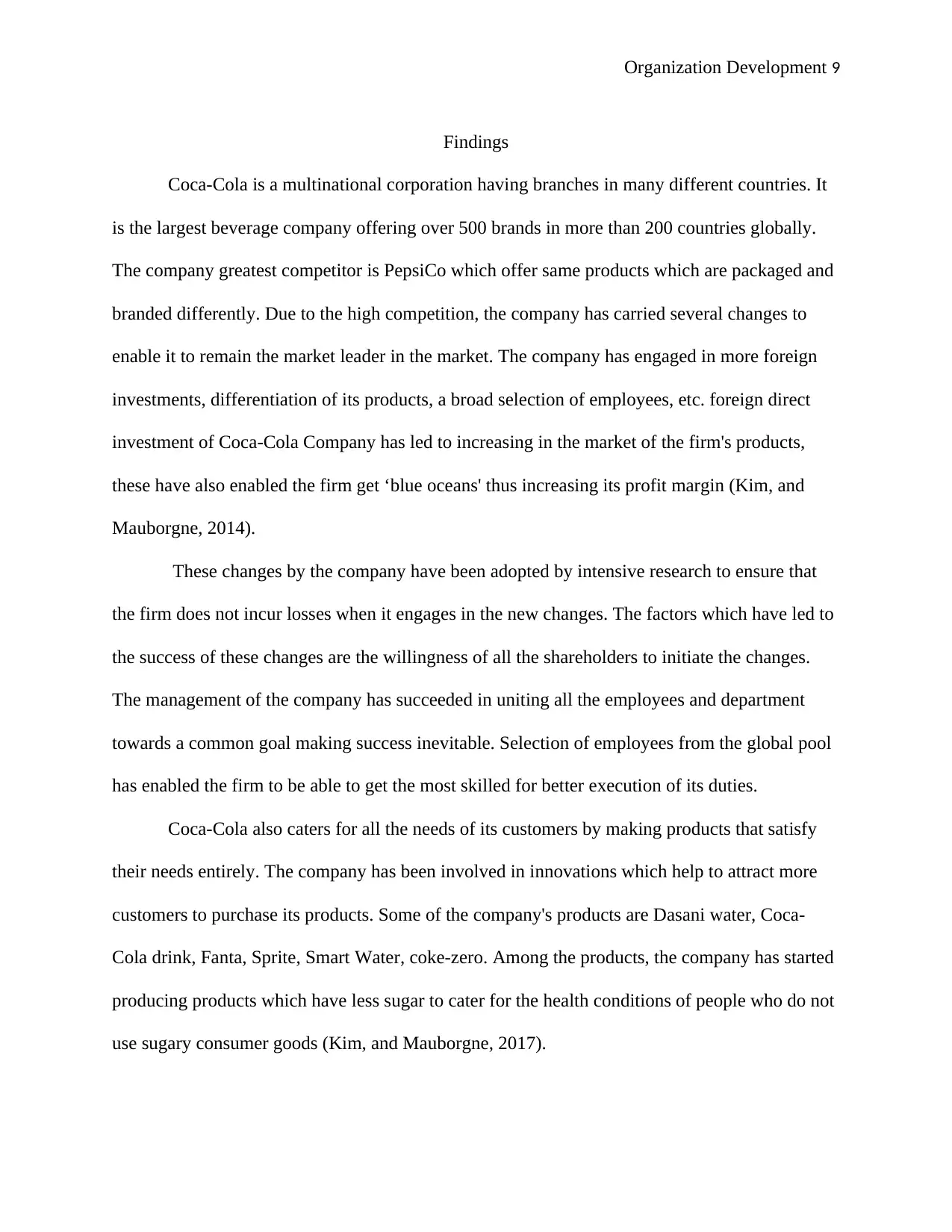
Organization Development 9
Findings
Coca-Cola is a multinational corporation having branches in many different countries. It
is the largest beverage company offering over 500 brands in more than 200 countries globally.
The company greatest competitor is PepsiCo which offer same products which are packaged and
branded differently. Due to the high competition, the company has carried several changes to
enable it to remain the market leader in the market. The company has engaged in more foreign
investments, differentiation of its products, a broad selection of employees, etc. foreign direct
investment of Coca-Cola Company has led to increasing in the market of the firm's products,
these have also enabled the firm get ‘blue oceans' thus increasing its profit margin (Kim, and
Mauborgne, 2014).
These changes by the company have been adopted by intensive research to ensure that
the firm does not incur losses when it engages in the new changes. The factors which have led to
the success of these changes are the willingness of all the shareholders to initiate the changes.
The management of the company has succeeded in uniting all the employees and department
towards a common goal making success inevitable. Selection of employees from the global pool
has enabled the firm to be able to get the most skilled for better execution of its duties.
Coca-Cola also caters for all the needs of its customers by making products that satisfy
their needs entirely. The company has been involved in innovations which help to attract more
customers to purchase its products. Some of the company's products are Dasani water, Coca-
Cola drink, Fanta, Sprite, Smart Water, coke-zero. Among the products, the company has started
producing products which have less sugar to cater for the health conditions of people who do not
use sugary consumer goods (Kim, and Mauborgne, 2017).
Findings
Coca-Cola is a multinational corporation having branches in many different countries. It
is the largest beverage company offering over 500 brands in more than 200 countries globally.
The company greatest competitor is PepsiCo which offer same products which are packaged and
branded differently. Due to the high competition, the company has carried several changes to
enable it to remain the market leader in the market. The company has engaged in more foreign
investments, differentiation of its products, a broad selection of employees, etc. foreign direct
investment of Coca-Cola Company has led to increasing in the market of the firm's products,
these have also enabled the firm get ‘blue oceans' thus increasing its profit margin (Kim, and
Mauborgne, 2014).
These changes by the company have been adopted by intensive research to ensure that
the firm does not incur losses when it engages in the new changes. The factors which have led to
the success of these changes are the willingness of all the shareholders to initiate the changes.
The management of the company has succeeded in uniting all the employees and department
towards a common goal making success inevitable. Selection of employees from the global pool
has enabled the firm to be able to get the most skilled for better execution of its duties.
Coca-Cola also caters for all the needs of its customers by making products that satisfy
their needs entirely. The company has been involved in innovations which help to attract more
customers to purchase its products. Some of the company's products are Dasani water, Coca-
Cola drink, Fanta, Sprite, Smart Water, coke-zero. Among the products, the company has started
producing products which have less sugar to cater for the health conditions of people who do not
use sugary consumer goods (Kim, and Mauborgne, 2017).
⊘ This is a preview!⊘
Do you want full access?
Subscribe today to unlock all pages.

Trusted by 1+ million students worldwide
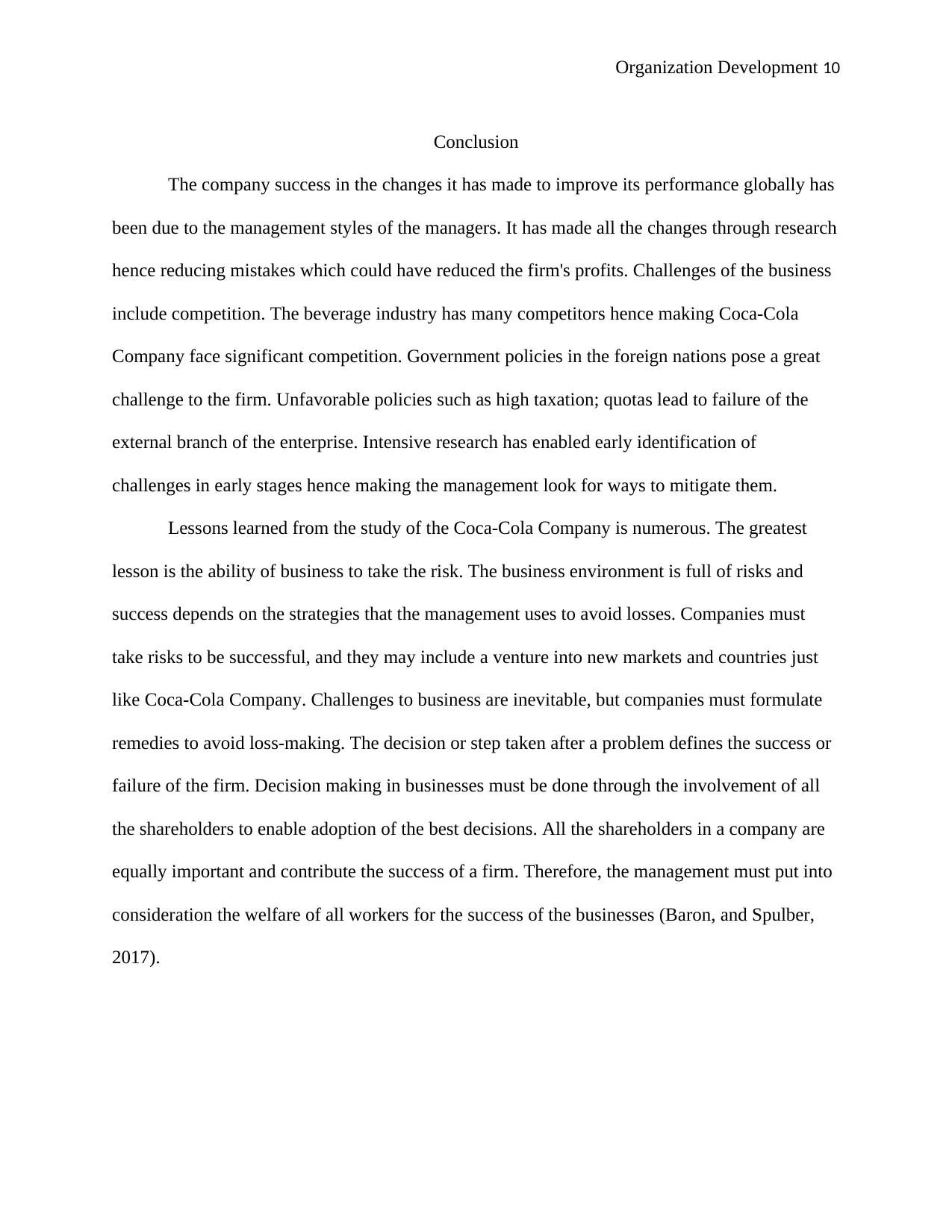
Organization Development 10
Conclusion
The company success in the changes it has made to improve its performance globally has
been due to the management styles of the managers. It has made all the changes through research
hence reducing mistakes which could have reduced the firm's profits. Challenges of the business
include competition. The beverage industry has many competitors hence making Coca-Cola
Company face significant competition. Government policies in the foreign nations pose a great
challenge to the firm. Unfavorable policies such as high taxation; quotas lead to failure of the
external branch of the enterprise. Intensive research has enabled early identification of
challenges in early stages hence making the management look for ways to mitigate them.
Lessons learned from the study of the Coca-Cola Company is numerous. The greatest
lesson is the ability of business to take the risk. The business environment is full of risks and
success depends on the strategies that the management uses to avoid losses. Companies must
take risks to be successful, and they may include a venture into new markets and countries just
like Coca-Cola Company. Challenges to business are inevitable, but companies must formulate
remedies to avoid loss-making. The decision or step taken after a problem defines the success or
failure of the firm. Decision making in businesses must be done through the involvement of all
the shareholders to enable adoption of the best decisions. All the shareholders in a company are
equally important and contribute the success of a firm. Therefore, the management must put into
consideration the welfare of all workers for the success of the businesses (Baron, and Spulber,
2017).
Conclusion
The company success in the changes it has made to improve its performance globally has
been due to the management styles of the managers. It has made all the changes through research
hence reducing mistakes which could have reduced the firm's profits. Challenges of the business
include competition. The beverage industry has many competitors hence making Coca-Cola
Company face significant competition. Government policies in the foreign nations pose a great
challenge to the firm. Unfavorable policies such as high taxation; quotas lead to failure of the
external branch of the enterprise. Intensive research has enabled early identification of
challenges in early stages hence making the management look for ways to mitigate them.
Lessons learned from the study of the Coca-Cola Company is numerous. The greatest
lesson is the ability of business to take the risk. The business environment is full of risks and
success depends on the strategies that the management uses to avoid losses. Companies must
take risks to be successful, and they may include a venture into new markets and countries just
like Coca-Cola Company. Challenges to business are inevitable, but companies must formulate
remedies to avoid loss-making. The decision or step taken after a problem defines the success or
failure of the firm. Decision making in businesses must be done through the involvement of all
the shareholders to enable adoption of the best decisions. All the shareholders in a company are
equally important and contribute the success of a firm. Therefore, the management must put into
consideration the welfare of all workers for the success of the businesses (Baron, and Spulber,
2017).
Paraphrase This Document
Need a fresh take? Get an instant paraphrase of this document with our AI Paraphraser
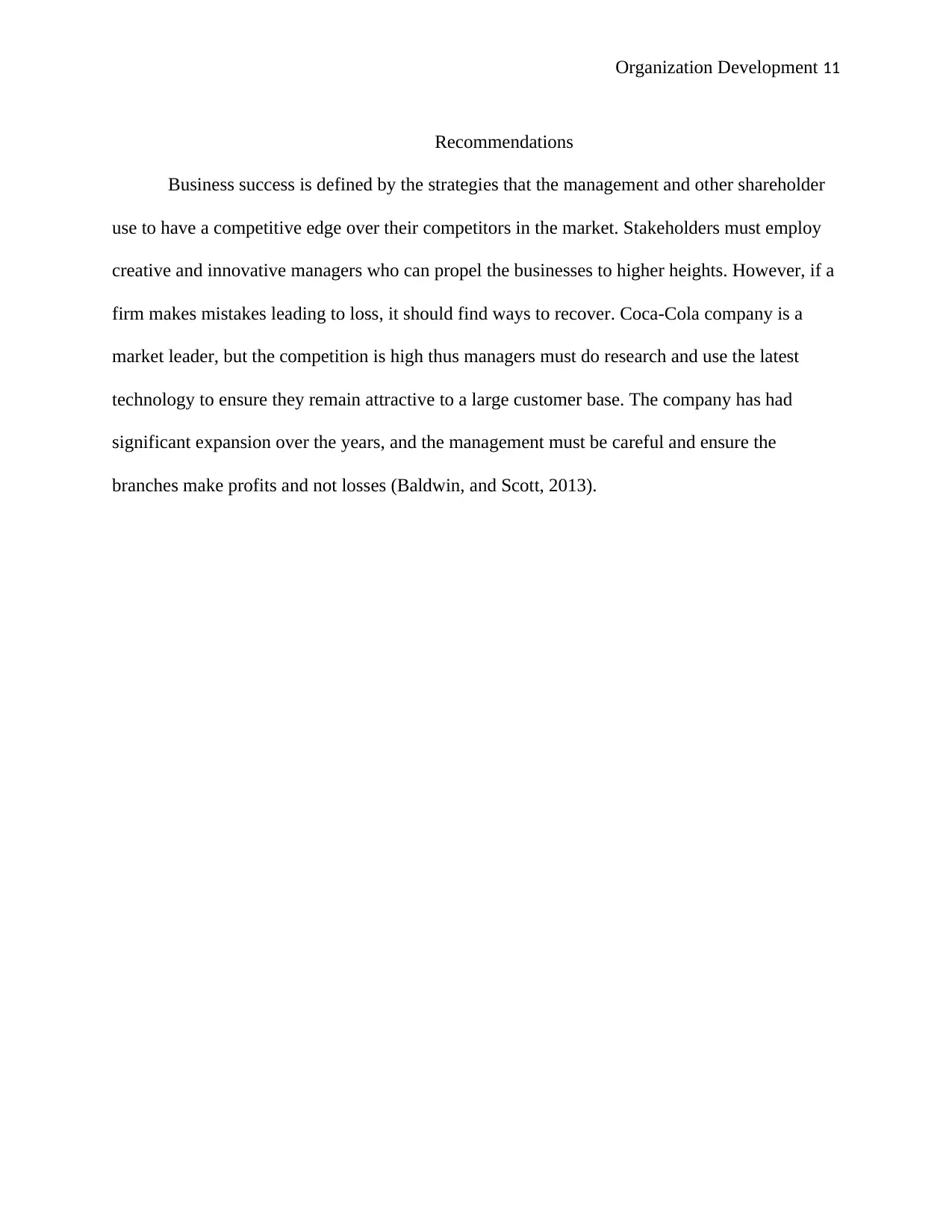
Organization Development 11
Recommendations
Business success is defined by the strategies that the management and other shareholder
use to have a competitive edge over their competitors in the market. Stakeholders must employ
creative and innovative managers who can propel the businesses to higher heights. However, if a
firm makes mistakes leading to loss, it should find ways to recover. Coca-Cola company is a
market leader, but the competition is high thus managers must do research and use the latest
technology to ensure they remain attractive to a large customer base. The company has had
significant expansion over the years, and the management must be careful and ensure the
branches make profits and not losses (Baldwin, and Scott, 2013).
Recommendations
Business success is defined by the strategies that the management and other shareholder
use to have a competitive edge over their competitors in the market. Stakeholders must employ
creative and innovative managers who can propel the businesses to higher heights. However, if a
firm makes mistakes leading to loss, it should find ways to recover. Coca-Cola company is a
market leader, but the competition is high thus managers must do research and use the latest
technology to ensure they remain attractive to a large customer base. The company has had
significant expansion over the years, and the management must be careful and ensure the
branches make profits and not losses (Baldwin, and Scott, 2013).
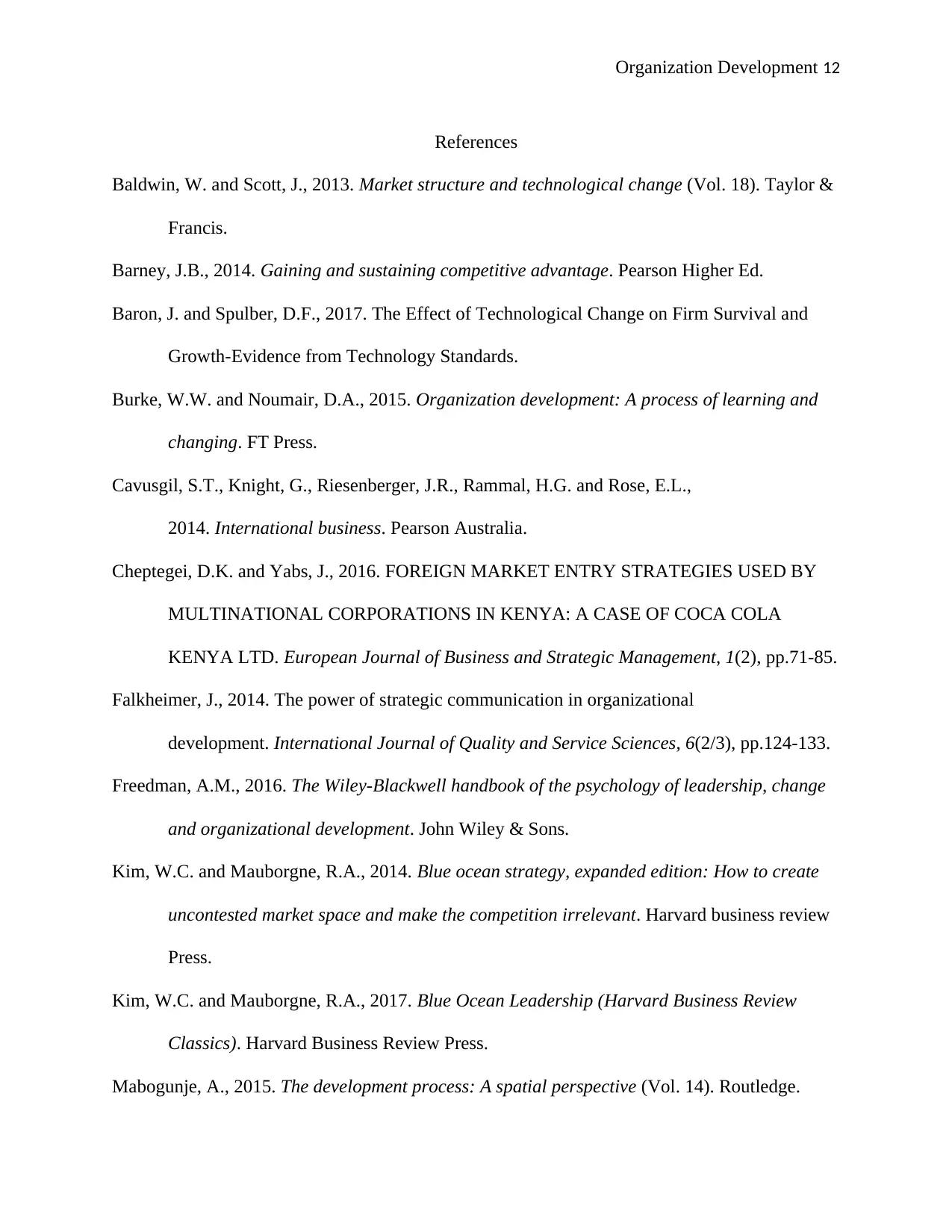
Organization Development 12
References
Baldwin, W. and Scott, J., 2013. Market structure and technological change (Vol. 18). Taylor &
Francis.
Barney, J.B., 2014. Gaining and sustaining competitive advantage. Pearson Higher Ed.
Baron, J. and Spulber, D.F., 2017. The Effect of Technological Change on Firm Survival and
Growth-Evidence from Technology Standards.
Burke, W.W. and Noumair, D.A., 2015. Organization development: A process of learning and
changing. FT Press.
Cavusgil, S.T., Knight, G., Riesenberger, J.R., Rammal, H.G. and Rose, E.L.,
2014. International business. Pearson Australia.
Cheptegei, D.K. and Yabs, J., 2016. FOREIGN MARKET ENTRY STRATEGIES USED BY
MULTINATIONAL CORPORATIONS IN KENYA: A CASE OF COCA COLA
KENYA LTD. European Journal of Business and Strategic Management, 1(2), pp.71-85.
Falkheimer, J., 2014. The power of strategic communication in organizational
development. International Journal of Quality and Service Sciences, 6(2/3), pp.124-133.
Freedman, A.M., 2016. The Wiley-Blackwell handbook of the psychology of leadership, change
and organizational development. John Wiley & Sons.
Kim, W.C. and Mauborgne, R.A., 2014. Blue ocean strategy, expanded edition: How to create
uncontested market space and make the competition irrelevant. Harvard business review
Press.
Kim, W.C. and Mauborgne, R.A., 2017. Blue Ocean Leadership (Harvard Business Review
Classics). Harvard Business Review Press.
Mabogunje, A., 2015. The development process: A spatial perspective (Vol. 14). Routledge.
References
Baldwin, W. and Scott, J., 2013. Market structure and technological change (Vol. 18). Taylor &
Francis.
Barney, J.B., 2014. Gaining and sustaining competitive advantage. Pearson Higher Ed.
Baron, J. and Spulber, D.F., 2017. The Effect of Technological Change on Firm Survival and
Growth-Evidence from Technology Standards.
Burke, W.W. and Noumair, D.A., 2015. Organization development: A process of learning and
changing. FT Press.
Cavusgil, S.T., Knight, G., Riesenberger, J.R., Rammal, H.G. and Rose, E.L.,
2014. International business. Pearson Australia.
Cheptegei, D.K. and Yabs, J., 2016. FOREIGN MARKET ENTRY STRATEGIES USED BY
MULTINATIONAL CORPORATIONS IN KENYA: A CASE OF COCA COLA
KENYA LTD. European Journal of Business and Strategic Management, 1(2), pp.71-85.
Falkheimer, J., 2014. The power of strategic communication in organizational
development. International Journal of Quality and Service Sciences, 6(2/3), pp.124-133.
Freedman, A.M., 2016. The Wiley-Blackwell handbook of the psychology of leadership, change
and organizational development. John Wiley & Sons.
Kim, W.C. and Mauborgne, R.A., 2014. Blue ocean strategy, expanded edition: How to create
uncontested market space and make the competition irrelevant. Harvard business review
Press.
Kim, W.C. and Mauborgne, R.A., 2017. Blue Ocean Leadership (Harvard Business Review
Classics). Harvard Business Review Press.
Mabogunje, A., 2015. The development process: A spatial perspective (Vol. 14). Routledge.
⊘ This is a preview!⊘
Do you want full access?
Subscribe today to unlock all pages.

Trusted by 1+ million students worldwide
1 out of 15
Related Documents
Your All-in-One AI-Powered Toolkit for Academic Success.
+13062052269
info@desklib.com
Available 24*7 on WhatsApp / Email
![[object Object]](/_next/static/media/star-bottom.7253800d.svg)
Unlock your academic potential
Copyright © 2020–2025 A2Z Services. All Rights Reserved. Developed and managed by ZUCOL.





